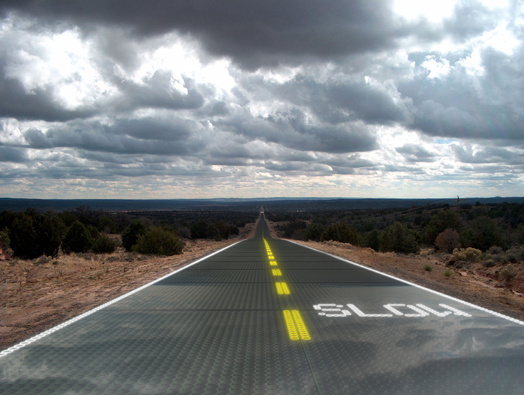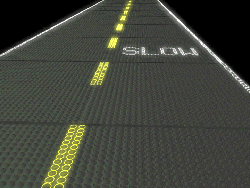 Just when you thought it was safe to say you understood what someone means when they say, “I’m driving on sun” – as in I’m driving an EV whose batteries have been charged with electricity generated by solar panels — someone comes along and messes it all up.
Just when you thought it was safe to say you understood what someone means when they say, “I’m driving on sun” – as in I’m driving an EV whose batteries have been charged with electricity generated by solar panels — someone comes along and messes it all up.
Meet Scott Brusaw, an electrical engineer who’s managing to create quite a buzz with his futuristic Solar Roadway™ concept, or the idea for a road made of solar panels encased in extra-, extra-, extra-strong glass.
If Brusaw’s dreams become reality, you might be driving on sun power and literally be driving your car on the very thing that generated the sun power you’re driving on.
Brusaw envisions an asphalt free – and emissions free world – powered entirely by Solar Roadways.
{googleAds}
<div style="float:left">
<script type="text/javascript"><!--
google_ad_client = "pub-7703542917199961";
/* 200x200, created 12/8/09 */
google_ad_slot = "7950368454";
google_ad_width = 200;
google_ad_height = 200;
//-->
</script>
<script type="text/javascript"
src="http://pagead2.googlesyndication.com/pagead/show_ads.js">
</script>
</div>
{/googleAds}In a press release on SolarRoadways.Com – which has generated more than 80,000 hits and has become so popular so quickly that Brusaw entreats users not to send him an e-mail unless it’s absolutely necessary because he’s “overwhelmed” – Brusaw writes:
“The idea is to replace all current petroleum-based asphalt roads, parking lots, and driveways with Solar Road Panels™ that collect and store solar energy to be used by our homes and businesses.”
How will it work?
Three-layers to Solar Roadway
Each individual panel in the Solar Roadway will consist of three layers: a road surface layer, an electronics layer, and a base-plate layer.
According to Brusaw, the road surface layer will be translucent and high-strength, rough enough to provide great traction yet still allow sunlight to pass through to the solar collector cells. Brusaw says this weatherproof layer will be capable of handling today’s heaviest loads under the worst conditions.
The electronics layer will contain a large array of cells, most of them solar collecting cells with LEDs for “painting” the road surface. These cells also contain the “Super” or “Ultra” caps which will store the sun’s energy for later use.
Solar Roadways won’t be cheap. Then again, neither is constructing and maintaining the existing American roadway system.
Brusaw claims as well that the Solar Roadway will eliminate the need for snow-plowing and ice removal. Instead, sun-generated energy stored in the roadway itself will melt ice and snow.
YouTube Video of YERT Interview
with Scott Brusaw
Below is an interview with Scott Brusaw conducted by YERT. YERT, which stands for “Your Environmental Road Trip,” is a one-year, 50-state video documentary road trip to explore and personalize sustainability across the country.
The final layer of the system is what Brusaw calls the base plate layer. This layer will distribute power (collected from the electronics layer) and data signals (phone, TV, internet, etc.) to all homes and businesses connected to the Solar Roadway™.
Brusaw, who recently received a $100,000 U.S. Department of Transportation Grant to develop his Solar Roadways project, hopes Solar Roadways will replace pretty much the entire American roadway grid, meaning driveways, parking lots, interstate highways, state routes, downtown streets, residential streets, and even plain dirt or gravel country roads.
 13,000 billion kWh of electricity
13,000 billion kWh of electricity
How much energy would Brusaw’s dream Solar Roadways system – extending over 25,000 square miles of American roadway space – generate?
The answer, according to Brusaw’s calculations – and he claims these are “conservative”: More than 13,000 billion kWh of electricity each year.
That’s roughly enough to cover America’s entire annual electricity needs three times over.
Solar Roadways won’t be cheap. Then again, neither is constructing and maintaining the existing American roadway system.
In order to accurately and fairly compare costs, notes Brusaw, one must take into account a number of costs associated with the current roadway and electric power generating system. These include:
- the cost of putting down and maintaining an asphalt roadway system;
- the cost of building and maintaining current power plants, which Solar Roadways would supplant;
- the cost of building and maintaining the current power distribution system, which currently includes multiple hubs that must then transport power to far flung places;
- the cost of coal, natural gas and other forms of fuel used to generate electricity;
Brusaw doesn’t include the cost of mining and drilling for goal, oil and natural gas, or the cost of gas for drivers — though he does note the high environmental costs associated with burning fossil fuels to create electricity and to fuel the world’s transportation infrastructure.

Cost same as for current system says inventor
Brusaw concludes that “for roughly the same cost of the current systems — asphalt roads and fossil fuel burning electricity generation plants, Solar Roadways™ can be implemented”.
No doubt, many will brand Brusaw’s Solar Roadway “pie in the sky.”
However, as outlandish as his ideas might appear to some, Brusaw is being much more realistic about a reality much of the rest of America appears to be denying: The reality of oil as a finite resource most likely unable to meet global humanity’s rapidly growing demand for more than a few decades and certainly unable to do so beyond the end of this century.
 Like this story? Interested in the solar-EV/PHEV synergy? Join our Sun Miles™ Club and start meeting & interacting with other people around the world who want to — or already are — driving their cars on sun! Register to join us today!
Like this story? Interested in the solar-EV/PHEV synergy? Join our Sun Miles™ Club and start meeting & interacting with other people around the world who want to — or already are — driving their cars on sun! Register to join us today!


